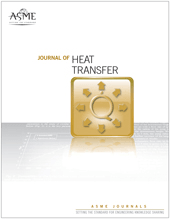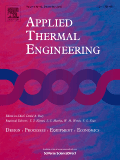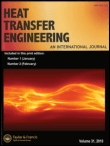
Journal of Nanofluids
Scope & Guideline
Pioneering Advances in Nanofluid Technology
Introduction
Aims and Scopes
- Nanofluid Thermodynamics and Heat Transfer:
Research in this area emphasizes the thermal properties of nanofluids, including their heat transfer capabilities, thermal conductivity, and the implications of these properties in applications such as heat exchangers and cooling systems. - Magnetohydrodynamics (MHD) in Nanofluids:
The journal covers studies on the effects of magnetic fields on nanofluid flow, exploring phenomena such as MHD heat transfer and the influence of magnetic forces on fluid dynamics. - Computational and Analytical Modeling:
A significant focus is on the development and application of computational models, including numerical simulations and analytical solutions, to study fluid behavior, heat transfer, and stability in nanofluid systems. - Bioconvection and Environmental Applications:
Research on bioconvective flows involving nanofluids and their applications in environmental and biomedical engineering is a core area, highlighting the interaction between microorganisms and fluid dynamics. - Non-Newtonian Fluid Dynamics:
The journal includes studies on non-Newtonian nanofluids, analyzing how variations in viscosity and flow behavior affect heat transfer and fluid dynamics in different applications. - Hybrid Nanofluids:
There is a growing interest in hybrid nanofluids, which combine different nanoparticles to enhance thermal and flow characteristics, making them suitable for advanced cooling applications.
Trending and Emerging
- Advanced Heat Transfer Applications:
There is an increasing trend towards exploring advanced applications of nanofluids in heat exchangers, solar collectors, and cooling systems, emphasizing their enhanced heat transfer capabilities. - Magneto-Bioconvection Studies:
Research on the interaction between nanofluids and biological systems, particularly in bioconvection scenarios, is gaining popularity, reflecting a growing interest in their potential for biomedical applications. - Nonlinear Dynamics and Stability Analysis:
Emerging studies focusing on the nonlinear dynamics of nanofluids, including stability analysis under various conditions, are becoming more prevalent, showcasing the complex behavior of these fluids. - Hybrid Nanofluids and Their Applications:
The exploration of hybrid nanofluids, which utilize multiple types of nanoparticles to optimize thermal properties, is on the rise, driven by their potential for improved performance in various applications. - Energy Efficiency and Sustainability:
Research efforts are increasingly directed towards evaluating the energy efficiency and environmental sustainability of nanofluids, particularly in renewable energy applications like solar thermal systems.
Declining or Waning
- Basic Nanofluid Properties Studies:
Research focusing solely on the basic physical and chemical properties of nanofluids without application context has seen a decline. The trend is shifting towards more application-driven studies that demonstrate practical uses of nanofluids. - Single-Phase Nanofluid Studies:
There is a noticeable reduction in studies that only consider single-phase nanofluids. Researchers are increasingly exploring hybrid and multiphase systems, which offer more complex and applicable insights. - Static Analysis of Nanofluids:
Static or equilibrium analysis of nanofluids is becoming less common. The journal's focus is shifting toward dynamic systems and transient analyses that better reflect real-world applications. - Nanofluid Production Techniques:
Research focused primarily on the synthesis and characterization of nanofluids is waning, as more emphasis is placed on innovative applications and performance evaluations in engineering contexts.
Similar Journals

JOURNAL OF POROUS MEDIA
Illuminating Complexities of Porous StructuresJOURNAL OF POROUS MEDIA is a prominent interdisciplinary journal published by Begell House Inc, focusing on the advancement of knowledge related to porous media across various fields, including Biomedical Engineering, Condensed Matter Physics, Materials Science, and Mechanical Engineering. With its ISSN 1091-028X and E-ISSN 1934-0508, this journal serves as a vital platform for researchers and professionals to disseminate groundbreaking findings and foster collaboration within the scientific community. The journal is ranked in the Q2 and Q3 quartiles in multiple categories as of 2023, demonstrating a notable standing in Scopus rankings across several engineering and physics disciplines. Though not an open-access journal, it provides essential insights and advancements within the field of porous media research, encouraging innovative exploration and practical applications in real-world scenarios. Published from 1998 through 2024, JOURNAL OF POROUS MEDIA is an invaluable resource for students, researchers, and industry experts seeking to deepen their understanding of complex porous systems.

Journal of Thermal Science
Pioneering insights in thermal science and engineering.Journal of Thermal Science is a prestigious academic publication dedicated to the field of thermal science and its applications. Published by SPRINGER, this journal has been at the forefront of knowledge dissemination since its inception in 1992 and continues to provide a platform for researchers and professionals to share their innovative findings through high-quality peer-reviewed articles. With its ISSN 1003-2169 and E-ISSN 1993-033X, the journal covers a diverse array of topics related to thermal processes, materials, and engineering, significantly contributing to advancements in Condensed Matter Physics. In the latest rankings, it holds a commendable Q2 category in the 2023 quartiles, further highlighting its relevance with a Scopus ranking of #183/434 in its field, placing it in the top 57th percentile. While currently not offering open access, the journal strives to bridge the gap between theory and practice, making substantial impacts on both academia and industry. Its continued exploration of cutting-edge research ensures that it remains a key resource for students and professionals looking to expand their knowledge and foster innovation in thermal sciences.

JOURNAL OF HEAT TRANSFER-TRANSACTIONS OF THE ASME
Fostering Innovation in Heat Transfer Technologies.JOURNAL OF HEAT TRANSFER-TRANSACTIONS OF THE ASME, with ISSN 0022-1481 and E-ISSN 1528-8943, is a leading publication in the field of heat transfer, mechanical engineering, and related disciplines, published by the renowned American Society of Mechanical Engineers (ASME). This esteemed journal, which has been in circulation since 1945, provides a platform for novel research findings and reviews that the mechanical engineering community can rely upon, contributing significantly to the advancement of knowledge in heat transfer processes. The journal is recognized for maintaining a strong impact in several categories, attaining Q2 quartile rankings in Condensed Matter Physics, Mechanical Engineering, and Mechanics of Materials, reflecting its influential role in shaping scientific dialogues. With a commendable Scopus ranking, including a percentile of 63rd in Mechanical Engineering, it attracts submissions from leading researchers and industry professionals alike. Although access options are currently undergoing changes, the commitment to disseminating cutting-edge research remains steadfast. Gathering insights from historical and contemporary studies, the JOURNAL OF HEAT TRANSFER stands as a vital resource for those aiming to innovate in heat transfer technologies and methodologies.

Frontiers in Heat and Mass Transfer
Empowering the Future of Engineering and Materials ScienceFrontiers in Heat and Mass Transfer is a premier open-access journal published by TECH SCIENCE PRESS that focuses on the interdisciplinary field of heat and mass transfer. Established in 2010, this journal has been pivotal in disseminating high-quality research aimed at advancing the understanding of energy and material transport phenomena. With an impressive commitment to open access, it ensures that all published articles are readily available to researchers, practitioners, and students globally, promoting knowledge sharing and collaboration. The journal currently holds a Q3 ranking in key categories such as Engineering, Materials Science, and Physics and Astronomy, as well as notable positioning in Scopus rankings. With a forward-looking scope extending from 2010 to 2024, Frontiers in Heat and Mass Transfer continues to be an essential platform for innovative research, fostering the development of practical applications across various scientific and engineering domains. We invite you to explore the latest contributions to this evolving field and consider this journal as a vital resource for your academic and professional growth.

Propulsion and Power Research
Driving Progress in Fluid Flow and Transfer Processes.Propulsion and Power Research, published by KEAI PUBLISHING LTD, is a leading Open Access journal that has been advancing the field of propulsion and power systems since its inception in 2012. With its commitment to fostering scientific discourse and innovation, the journal has gained a prominent position within academia, achieving a Q1 ranking in multiple categories such as Aerospace Engineering, Automotive Engineering, and Fluid Flow and Transfer Processes as of 2023. With an impressive ranking of #18 out of 153 in Aerospace Engineering and consistent recognition in the Scopus rankings, the journal explores critical advancements and research findings that propel the industry forward. As an Open Access publication, it ensures that groundbreaking research is readily available to a broad audience, enhancing collaboration between researchers, practitioners, and students. The journal's scope encompasses a wide range of topics within propulsion and energy solutions, making it an essential resource for anyone keen on discovering significant developments in this dynamic field.

Heat Transfer
Unlocking the secrets of heat transfer for enhanced performance.Heat Transfer, published by WILEY, is a leading open-access journal dedicated to advancing the field of heat transfer science, encompassing innovative research and application across various domains. With an ISSN of 2688-4534 and an E-ISSN of 2688-4542, the journal aims to provide a platform for researchers to disseminate their findings from 2020 to 2024, focusing on condensed matter physics and fluid dynamics. Ranked in the Q2 category for both Condensed Matter Physics and Fluid Flow and Transfer Processes, it showcases articles that contribute significantly to the understanding and utilization of heat transfer mechanisms. Located in the United States at 111 River St, Hoboken, NJ 07030, the journal appeals to a diverse audience, including academic researchers, professionals in engineering, and students seeking to deepen their knowledge in thermal sciences. With a strong emphasis on accessibility, Heat Transfer promotes the exchange of ideas and experimental techniques, ultimately driving innovation and collaboration in the advancement of thermal management technologies.

INTERNATIONAL JOURNAL OF HEAT AND FLUID FLOW
Exploring Innovations in Thermal and Fluid SystemsFounded in 1979, the INTERNATIONAL JOURNAL OF HEAT AND FLUID FLOW is a premier publication in the fields of mechanical engineering, fluid dynamics, and heat transfer, published by Elsevier Science Inc. With an impressive impact factor and ranking in the Q1 category for Mechanical Engineering and Q2 for Condensed Matter Physics and Fluid Flow and Transfer Processes, this journal is highly regarded for its rigorous peer-reviewed articles that contribute significantly to the advancement of knowledge in these critical areas. Researchers, professionals, and students can access cutting-edge studies that explore the intricacies of thermal and fluid systems, ensuring they stay at the forefront of scientific exploration. The Scopus rankings further affirm its role as a leading source of impactful research, with significant placements in crucial academic categories. Join an active community of scholars committed to innovation and excellence in the exploration of heat and fluid flow phenomena.

APPLIED THERMAL ENGINEERING
Empowering engineers with cutting-edge thermal insights.Applied Thermal Engineering is a leading international journal dedicated to the field of thermal engineering, published by Pergamon-Elsevier Science Ltd. With an impressive impact factor indicating its significance in the academic community, this journal focuses on innovative research and developments related to energy engineering, fluid flow, and transfer processes, as well as manufacturing and mechanical engineering. Being indexed in top quartiles (Q1) across multiple categories, it ranks exceptionally well on platforms like Scopus, ensuring that contributors reach a wide and relevant audience. The journal supports both open access and subscription options, promoting the dissemination of vital research findings from 1996 to 2024. With its commitment to advancing the discipline and implementing rigorous peer-review processes, Applied Thermal Engineering serves as an essential resource for researchers, industry professionals, and students aiming to stay abreast of the latest advancements and applied methodologies in thermal science.

HEAT TRANSFER ENGINEERING
Elevating standards in thermal engineering research and practice.HEAT TRANSFER ENGINEERING is a leading international journal published by Taylor & Francis Inc, dedicated to advancing the field of heat transfer and thermal engineering. With a strong focus on the key aspects of Condensed Matter Physics, Fluid Flow and Transfer Processes, and Mechanical Engineering, this journal covers a comprehensive range of topics from experimental studies to theoretical analysis, aiming to foster innovative research and practical applications. Since its inception in 1979 and continuing through 2024, the journal has established itself as an essential resource for researchers and industry professionals alike, reflected in its solid rankings within Scopus—holding a Q2 quartile classification in multiple engineering disciplines. Although not open access, the journal ensures broad accessibility through institutional subscriptions, making cutting-edge research readily available. With its rigorous peer-review process and commitment to quality, HEAT TRANSFER ENGINEERING plays a crucial role in shaping the future of thermal management solutions and engineering practices.

Computational Thermal Sciences
Advancing the Frontiers of Thermal InnovationComputational Thermal Sciences, an esteemed journal published by BEGELL HOUSE INC, presents cutting-edge research at the intersection of computational mathematics, energy engineering, and fluid dynamics. With an ISSN of 1940-2503 and an E-ISSN of 1940-2554, this journal aims to disseminate high-quality research articles, reviews, and methodologies that improve our understanding of thermal processes and their applications. Renowned for its solid impact in the field, it holds a Q3 ranking in multiple categories including Computational Mathematics and Energy Engineering for 2023. As the field evolves, the journal continues to play a pivotal role in bridging theoretical research with practical innovations, thereby catering to a diverse audience of researchers, professionals, and students. Although it operates on a subscription model, the journal ensures accessibility to significant contributions in thermal sciences from 2009 to 2024, fostering an environment of knowledge sharing and collaboration.